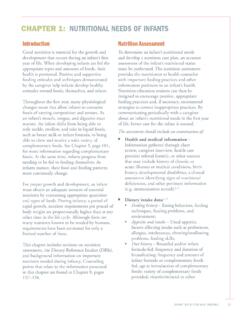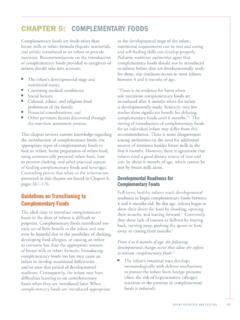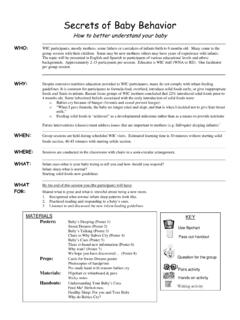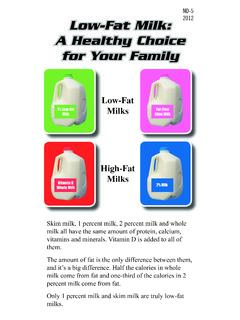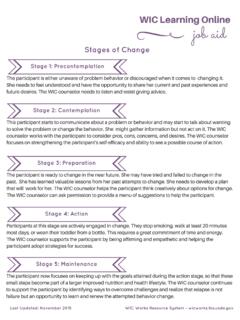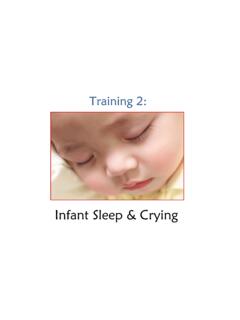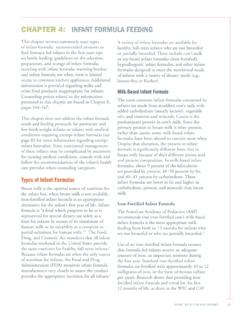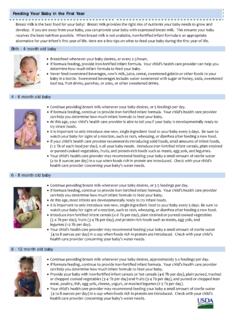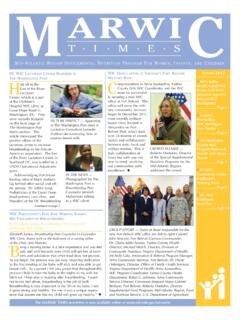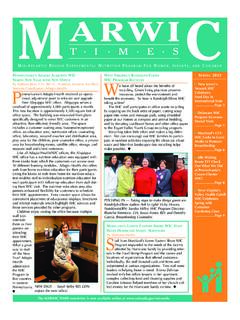Transcription of CHILDHOOD AND POST PARTUM NUTRITION CLIENT …
1 CHILDHOOD AND post PARTUM NUTRITION CLIENT DISCUSSION SESSIONS SELECTION OF CHILDHOOD AND post PARTUM DISCUSSION SESSIONS "Your Own Eating Style: How To Fit It Into the Pyramid." (Session C-1 and L-1) During this session, the CLIENT will nceive Wtdual counseling~m a qu&&d nubitionist and &sign their own nutrilion gaols lo fit within the Food Guide Pymmid in ordcr lo improve their nutdhnal s~~hu and weCIbcing. "Eating Within the Pyramid." (Session C-2) The CLIENT will continut to work on their Widual nubition gaols using the Food Guide Pyramid as a jiumework and &velop at bast one sbutegy to meet their gd "Taking Care of Yourself." (Session L-2) The postpartum CLIENT willsctpcrsonalgoaLF lo take cm of her~e~~ the bbth of the My,& identify stmlegies 10 manage the change in her we as a nsult of the new kby. "Your Child's Developmental Stages." (Session C-3) Theclicntwill~&wtheirclrild's&velopmenlo l~lll~nlaudto whatthecAUd&ah&loeat, and sham &as for new and upprop* fd lo oger their clWd Iksd on their child's &yclopmenlol stage.
2 "Creative Healthy Snacks for Kids." (Session C-4) The CLIENT will sh and nceive ideas for new and exciting healthy snack for chWmu. "Tooth or Consequences -- A Healthy Mouth" (Session C-5) The CLIENT will bum proper techniquts for taking can of their clrild's teeth as well as Lips for fan? good dental cam. "Ironing It Out -- Getting Enough Iron In Your Diet" (Session C-6) The CLIENT will shan their experience and learn mom aliout anemia and its effect on health, and how to identify foods high in iron content. "Creative Survival Kit For Your Lactose Intolerance and Milk Allergy." (Session C-7) Tk CLIENT will identify symptoms of their child's lactose intolemnce and will sham cnative ways to manage their child's diet and westyle. CHILDHOOD AND post PARTUM DISCUSSION SESSION: C-1 and L-1 CERTIFICATION OBJECTIVE: The WIC participants will receive individualized counseling from a nutritionist and identify a NUTRITION goal to improve their diet within the nutritionist's recommendations.
3 BACKGROUND INFORMATION: 1) "Facilitating WIC Discussion Groups" at the beginning of this document (page Intro- 1). 2) All sources listed in the CHILDHOOD and post PARTUM Study Guides may be relevant. 3) "Goal Setting" -- follows this summary. METHOD: The WIC nutritionist will use active listening skills to address the participant in a one-on- one discussion that targets particular concerns of each individual woman and/or child. The nutritionist will review CLIENT information, note possible areas of need, and provide information, referrals, and follow-up scheduling as necessary. MATERIALS NEEDED: 1) Food Guide Pyramid: A Guide to Daily Food Choices (Poster). 2) Food Frequency Tool. SESSION OUTLINE. 1) Opening the Session. (Note: for recertification, research goal from 6 months previously to discuss with CLIENT . Ask CLIENT about any progress toward the last goal and whether they want to keep that goal or set another one).
4 - - Assess diet. -- Assess other risk factors. -- Describe risks to CLIENT and describe intake assessment using the Food Guide Pyramid. Write in number of servings on Food Guide Pyramid. 2) Ask general, non-specific, open-ended questions to stimulate the participant and to focus on their diet and goal-setting: - - "Given what you've told me about your diet, what are some ideas you may have for working on it?" -- "lf you could do one very small thing to change your diet, what would you do?" - - "When you think of healthy eating what comes to mind?" - - "What is a healthy eating style and how will you get there?" Help the CLIENT choose one achievable goal to address for their certification period. Be sure that CLIENT 's goal is realistic. This entails taking only a small part of their long-term goal for the next few months. Be SUPPORTIVE and NON-JUDGEMENTAL. Document goal on Food Guide Pyramid and on Food Frequency Form.
5 Refer to "Goal , Setting" (Appendix). Explain how WIC foods will help to improve CLIENT 's diet and the importance of eating the food. Develop a NUTRITION plan for the participant. 3) Explain to the parent or guardian the importance of attending the NUTRITION discussion sessions. 4) Choose the discussion sessions the CLIENT would like for that cenifkation period. Note: if the CLIENT is a high risk CLIENT (for example, Priorities I-m), suggest that they attend the appropriate sessions tailored to their risk factors. 5) Refer other (lower-risk) program categories to WIC facilitated session summaries for their first session. 6) Summarize the key points of the goal set by the CLIENT . GOAL SETTING A goal is a particular kind of decision -- an action decision with a plan. To accomplish goals we need to believe that we have the ability to affect change. It helps to anticipate possible barriers, so these can be factored in for realistic success.
6 The object of goal-setting is to be successful, and change in small steps that over time will be monumental. By affecting health behaviors, we're hoping all our clients and their families live to be a hundred! * Goals Need To Be Specific and Measurable. If your CLIENT is unsure what they would like to do to improve their health-related lifestyle, have them describe, as thoroughly as possible, an area they wish to improve. This description will probably allow them many possibilities for small goals. They then need only pick the one or two they wish to try first. * Be Realistic, Not Perfectionistic. When goals are unrealistic, they often set the stage for failure. One may think the goal isn't dramatic enough, so why bother. The small successes set us up for bigger and bigger successes. Since change is a lifelong process, these small successes set the stage for continued growth.
7 We build self-confidence and self-esteem if we succeed even in the small things. Help your clients set themselves up for success. * Choose Small Steps That Focus On Behavior. Behaving in a consistent, persistent manner will produce the change that is desired. There may be a big goal at the end, but many, many small goals get us there. * Be Flexible and Reset Goals If Necessary. The American way is to bite off more than we can chew. When this happens, our clients need to give themselves permission to reset the goal. * Plan the Reward -- Even If It's a Compliment We Give Ourselves. Our clients need to congratulate themselves when a goal has been achieved. Doing this on a daily basis each time an action has been completed correctly offers positive reinforcement and helps assure that good behavior continues. Some class time spent in having the clients share their goal for change helps to firm up that goal in their minds.
8 By sharing it, they also tend to feel more committed to achieving it -- their word is on the line. If a CLIENT does not wish to share a goal, remember they have the option of passing and being respected for that decision. * Suggestions From the Experts. -- Write the goal on a card. -- Read the statement in the morning and before retiring at night. -- Visualize the accomplishment of the goal being as detailed as possible. -- Feel the great feeling of having accomplished your goal. Sources: "See You at the Top", Z. Zigler. "How To Put More Time In Your Life", D. Scott. "Seeds of Greamess", D. Waitley. CHILDHOOD DISCUSSION SESSION: C-2 FEELING GOOD BY EATING RIGHT ALTERNATIVE TITLES: "Healthy Eating, Ages 2-5". "Kid Power". "Growing Healthy Youngsters". "Sensible Eating During CHILDHOOD ". "Smart Food Buying". "The Food Guide Pyramid". "Point of Purchase". OBJECTIVE: The CLIENT will identify one NUTRITION goal to achieve a healthy diet and develop at least one method to improve their diet.
9 BACKGROUND INFORMATION: 1) "Getting Along With Milk", National Dairy Council, Rosemont, iL, 1987. 2) "How to Buy Fresh Fruits and Vegetables", United States Department of Agriculture Pamphlet, 1967. 3) "Good Eating for the Young Child", University of Iowa Hospital, Dietary Department, 1982. 4) "Child of Mine", E. Satter, Bull Publishing Co., Palo Alto, CA, 1991. 5) "Your Baby and Child", P. Leach; Alfred A. Knopf, New York, NY, 1992. 6) "Feeding Your Child", L. Lambert-Lagace; Toronto General Publishing, Toronto, 1982. 7) Child NUTRITION Pointers for children aged 1 to 5 years. 8) Motivation to Achieve a Healthy Diet: Self Esteem Exercise. METHOD: Involving participants in a facilitated group discussion. For this particular session, several "Alternative Methods" are listed before the study guide. MATERIALS NEEDED: 1) Five A Day Video (optional -- may be shown in the waiting room).
10 2) Food Pyramid Poster (optional). 3) Local Grocery Store Ad Circular (optional). 4) Flip Chart or Writing Board to list ideas. DISCUSSION TOPICS: Session Outline follows. SESSION OUTLINE: 1) Opening the Session. * Introductions: Introduce yourself. Give everyone the opportunity to know a little about each other, and to practice speaking to the group. Begin by having each person introduce themselves. * Icebreaker Exercise (optional -- see earlier section on "Facilitating WIC Discussion Groups", page Intro-7). 2) Ask general, non-specific, open-ended questions to open up the session and focus the discussion. For example: - - "Has anyone heard about the new Food Pyramid?" - - "How do you try to work variety into your diet?" - - "How do the pom'on sizes you receive in restaurants compare with those you usually eat at home?" - - "What are the barriers you see to eating a wider variety of foods?
